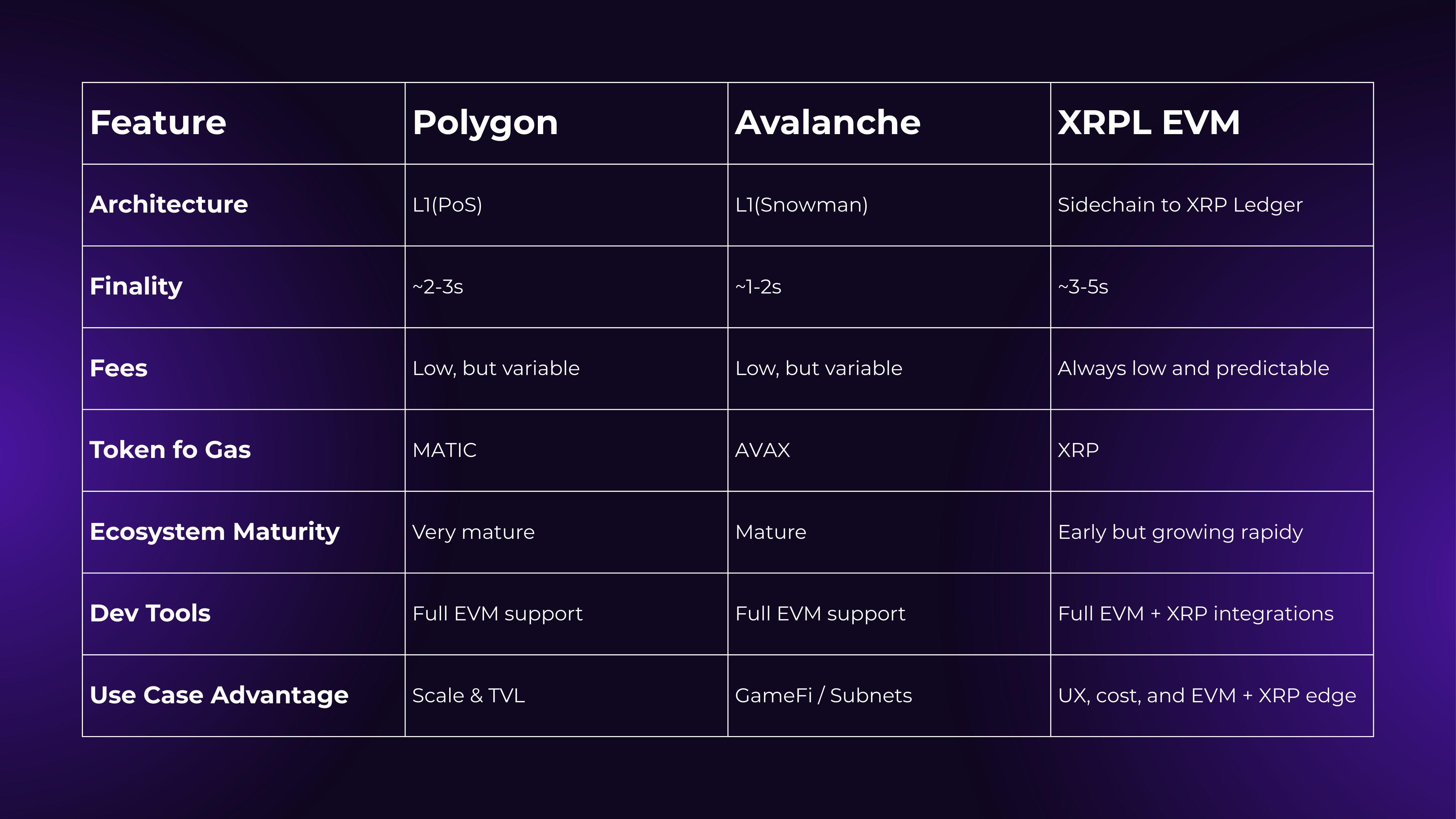XRPL EVM vs Other EVM-Compatible Blockchains
XRPL EVM vs Other EVM-Compatible Blockchains: What's the Difference?
In the evolving world of Web3, EVM compatibility has become a gold standard.
Chains like Polygon, Avalanche, Arbitrum, and Optimism offer developers an Ethereum-like experience - enabling smart contracts in Solidity, access to familiar tools, and easy dApp migration.
Now, XRPL EVM joins the field, bringing Ethereum programmability to one of the world’s fastest and most established blockchain ledgers: the XRP Ledger.
So how does XRPL EVM actually compare to other EVM-compatible chains?
Let’s break it down.
What do they have in common?
All major EVM-compatible chains - including XRPL EVM - share several core traits:
Solidity support: developers can write smart contracts using the language they already know
Tooling compatibility: Metamask, Hardhat, Remix, and more all work out of the box
Easy dApp portability: code and infrastructure can often be reused across networks
But the similarities stop there.
Once you look deeper, XRPL EVM starts to stand out.
Architecture: Sidechain vs Layer 1
Polygon, Avalanche, and similar chains are independent Layer 1 (L1) blockchains with their own full infrastructure and consensus mechanisms.
XRPL EVM, by contrast, is a dedicated sidechain connected to the XRP Ledger through bridges.
Why this matters:
A Layer 1 chain under heavy load or attack will slow down - or even halt - the entire ecosystem.
XRPL EVM, as a sidechain, operates independently of the XRP Ledger.
Even if the EVM chain is congested, the core XRP network continues to function smoothly.
📌 This separation offers enhanced reliability and isolation - ideal for enterprises or mission-critical dApps.
Fees: Predictable and low - always
Ethereum: often suffers from extreme gas fee volatility
Polygon & Avalanche: cheaper, but fees still fluctuate during peak activity
XRPL EVM: consistently low fees, paid in XRP, not a native gas token
Why developers and users care:
No need to manage a new token for fees
Easier onboarding for new users
Lower operational cost for frequent interactions
Example: A dApp with 10,000+ daily NFT interactions could save thousands per week simply by launching on XRPL EVM.
Speed and Finality
Ethereum (L1): ~13 seconds
Polygon: ~2–3 seconds
Avalanche: ~1–2 seconds
XRPL EVM: ~3–5 seconds - stable and predictable
While it may not be the fastest on paper, XRPL EVM provides reliable finality without sacrificing decentralization - something not all rollups or custom chains can claim.
Developer Experience
All chains: support Solidity, Remix, and Web3.js
XRPL EVM: adds XRP-specific integrations and predictable fee mechanics
Biggest edge:
Developers benefit from Ethereum familiarity plus the backing of a mature, battle-tested ledger (XRP Ledger) - without learning new languages (like Rust or Move).
Ecosystem maturity
Polygon: large ecosystem (Aave, Uniswap, Lens, OpenSea, etc.)
Avalanche: popular for GameFi, DeFi, and subnet infrastructure
XRPL EVM: early-stage - but fast-growing
Why this matters:
While Polygon and Avalanche offer crowded opportunity, XRPL EVM is a blue ocean.
New projects have a chance to stand out and become foundational - not just another fork in the crowd.
Use Cases Where XRPL EVM Shines
DeFi protocols needing low-cost liquidity movements
NFT marketplaces with frequent user interaction
Games requiring high transaction throughput
Tooling & infra companies seeking unique market positioning
Enterprises that value predictability and regulatory familiarity (via XRP)
Summary Table

In summary
XRPL EVM isn’t here to compete directly with Ethereum, Polygon, or Avalanche.
Instead, it creates a new lane - combining Ethereum’s developer ecosystem with the reliability, speed, and predictability of the XRP Ledger.
It’s ideal for:
builders launching their first dApp,
projects migrating from high-fee chains,
and anyone who values stable cost and user-friendly UX.
And as the ecosystem continues to evolve, XRPL EVM may just become the most practical blockchain for real-world Web3 adoption.